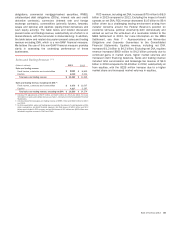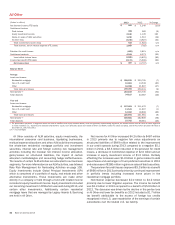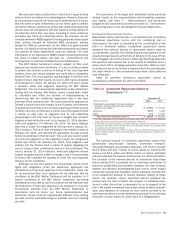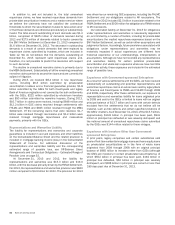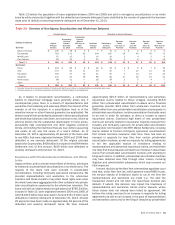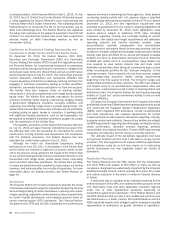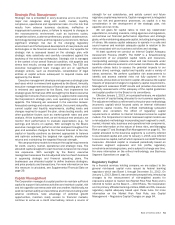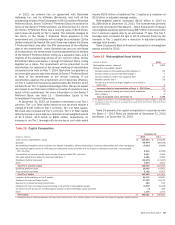Bank of America 2013 Annual Report Download - page 57
Download and view the complete annual report
Please find page 57 of the 2013 Bank of America annual report below. You can navigate through the pages in the report by either clicking on the pages listed below, or by using the keyword search tool below to find specific information within the annual report.Bank of America 2013 55
servicing rights, and foreclosure activities, including those claims
not covered by the National Mortgage Settlement. This scrutiny
may extend beyond our pending foreclosure matters to issues
arising out of alleged irregularities with respect to previously
completed foreclosure activities. We are also subject to inquiries,
investigations, actions and claims from regulators, trustees,
investors and other third parties relating to other mortgage-related
activities such as the purchase, sale, pooling, and origination and
securitization of loans, as well as structuring, marketing,
underwriting and issuance of MBS and other securities, including
claims relating to the adequacy and accuracy of disclosures in
offering documents and representations and warranties made in
connection with whole-loan sales or securitizations. The ongoing
environment of heightened scrutiny may subject us to
governmental or regulatory inquiries, investigations, actions,
penalties and fines, including by the DOJ, state Attorneys General
and other members of the RMBS Working Group of the Financial
Fraud Enforcement Task Force, or by other regulators or
government agencies that could significantly adversely affect our
reputation and result in material costs to us in excess of current
reserves and management’s estimate of the aggregate range of
possible loss for litigation matters. Recent actions by regulators
and government agencies indicate that they may, on an industry
basis, increasingly pursue claims under the Financial Institutions
Reform, Recovery, and Enforcement Act of 1989 (FIRREA) and the
False Claims Act (FCA). For example, the Civil Division of the U.S.
Attorney’s office for the Eastern District of New York is conducting
an investigation concerning our compliance with the requirements
of the Federal Housing Administration’s Direct Endorsement
Program. FIRREA contemplates civil monetary penalties as high
as $1.1 million per violation or, if permitted by the court, based
on pecuniary gain derived or pecuniary loss suffered as a result
of the violation. Treble damages are potentially available for FCA
claims. The ongoing environment of additional regulation,
increased regulatory compliance burdens, and enhanced
regulatory enforcement, combined with ongoing uncertainty
related to the continuing evolution of the regulatory environment,
has resulted in operational and compliance costs and may limit
our ability to continue providing certain products and services. For
more information on management’s estimate of the aggregate
range of possible loss and regulatory investigations, see Note 12
– Commitments and Contingencies to the Consolidated Financial
Statements.
Mortgage-related Settlements – Servicing Matters
In connection with the BNY Mellon Settlement, BANA has agreed
to implement certain servicing changes. The Trustee and BANA
have agreed to clarify and conform certain servicing standards
related to loss mitigation. In particular, the BNY Mellon Settlement
clarifies that it is permissible to apply the same loss mitigation
strategies to the Covered Trusts as are applied to BANA affiliates’
HFI portfolios. This portion of the agreement was effective in the
second quarter of 2011 and is not conditioned on final court
approval.
BANA also agreed to transfer the servicing rights related to
certain high-risk loans to qualified subservicers on a schedule that
began with the signing of the BNY Mellon Settlement. This servicing
transfer protocol will reduce the servicing fees payable to BANA
in the future. Upon final court approval of the BNY Mellon
Settlement, failure to meet the established benchmarking
standards for loans not in subservicing arrangements can trigger
payment of agreed-upon fees. Additionally, we and Countrywide
have agreed to work to resolve with the Trustee certain mortgage
documentation issues related to the enforceability of mortgages
in foreclosure and to reimburse the related Covered Trust for any
loss if BANA is unable to foreclose on the mortgage and the
Covered Trust is not made whole by a title policy because of these
issues. These agreements will terminate if final court approval of
the BNY Mellon Settlement is not obtained, although we could still
have exposure under the pooling and servicing agreements related
to the mortgages in the Covered Trusts for these issues.
In connection with the National Mortgage Settlement, BANA
has agreed to implement certain additional servicing changes. The
uniform servicing standards established under the National
Mortgage Settlement are broadly consistent with the residential
mortgage servicing practices imposed by the 2011 OCC Consent
Order; however, they are more prescriptive and cover a broader
range of our residential mortgage servicing activities. These
standards are intended to strengthen procedural safeguards and
documentation requirements associated with foreclosure,
bankruptcy and loss mitigation activities, as well as addressing
the imposition of fees and the integrity of documentation, with a
goal of ensuring greater transparency for borrowers. These uniform
servicing standards also obligate us to implement compliance
processes reasonably designed to provide assurance of the
achievement of these objectives. Compliance with the uniform
servicing standards is being assessed by a monitor based on the
measurement of outcomes with respect to these objectives.
Implementation of these uniform servicing standards has
contributed to elevated costs associated with the servicing
process, but is not expected to result in material delays or
dislocation in the performance of our mortgage servicing
obligations, including the completion of foreclosures.
Regulatory Matters
For more information regarding regulatory matters and risks, see
Item 1A. Risk Factors of this Annual Report on Form 10-K, Capital
Management – Regulatory Capital on page 61 and Note 12 –
Commitments and Contingencies to the Consolidated Financial
Statements.
Financial Reform Act
The Financial Reform Act, which was signed into law on July 21,
2010, enacted sweeping financial regulatory reform and has
altered and will continue to alter the way in which we conduct
certain businesses, increase our costs and reduce our revenues.
Many aspects of the Financial Reform Act remain subject to final
rulemaking which will take effect over several years, making it
difficult to anticipate the precise impact on the Corporation, our
customers or the financial services industry.
Debit Interchange Fees
On June 29, 2011, the Federal Reserve adopted a final rule with
respect to the Durbin Amendment effective on October 1, 2011
which, among other things, established a regulatory cap for many
types of debit interchange transactions to equal no more than
$0.21 plus five bps of the value of the transaction. The Federal
Reserve also adopted a rule to allow a debit card issuer to recover
$0.01 per transaction for fraud prevention purposes if the issuer
complies with certain fraud-related requirements, with which we
are currently in compliance. The Federal Reserve also approved
rules governing routing and exclusivity, requiring issuers to offer
two unaffiliated networks for routing transactions on each debit


